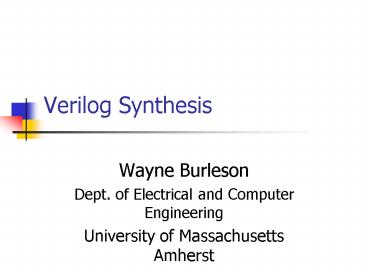Verilog Synthesis - PowerPoint PPT Presentation
1 / 19
Title:
Verilog Synthesis
Description:
How to use Verilog for behavioral (what) description ... module holiday_1(sat, sun, weekend); input sat, sun; output weekend; assign weekend = sat | sun; ... – PowerPoint PPT presentation
Number of Views:132
Avg rating:3.0/5.0
Title: Verilog Synthesis
1
Verilog Synthesis
- Wayne Burleson
- Dept. of Electrical and Computer Engineering
- University of Massachusetts Amherst
2
Objectives
- Get a feel for Verilog
- Hardware Description Language Semantics
- Verilog Syntax
- Features
- How to use Verilog for behavioral (what)
description - How to use Verilog for structural (how)
description - How to write Verilog for synthesis
- A Simple Example and a Larger Example
3
Readings
- M.H. Smith, ASICs , Addison Wesley Longman,
1997. We will only cover Chapters 11 and 12.
4
Why HDLs?
- Simulation
- Synthesis
- Documentation
5
How do HDLs differ from conventional programming
languages?
- Electricity
- Parallelism
- Time
6
//Counter Example timescale 1ns/1ns // Set the
units of time to be nanoseconds. module counter
reg clock // Declare a reg data type for the
clock. integer count // Declare an integer
data type for the count. initial // Initialize
things this executes once at t0. begin
clock 0 count 0 // Initialize signals.
340 finish // Finish after 340 time ticks.
end / An always statement to generate the
clock only one statement follows the always so
we don't need a begin and an end. / always 10
clock clock // Delay (10ns) is set to half
the clock cycle. / An always statement to do the
counting this executes at the same time
(concurrently) as the preceding always statement.
/ always begin // Wait here until the clock
goes from 1 to 0. _at_ (negedge clock) //
Now handle the counting. if (count 7)
count 0 else count count 1
display("time ",time," count ", count)
end endmodule
7
gt verilog counter.v VERILOG-XL 2.2.1 Apr 17,
1996 114818 ... Banner information omitted
here... Compiling source file "counter.v" Highest
level modules counter time
20 count 1 time
40 count 2 (... 12 lines
omitted...) time 300 count
7 time 320 count
0 L10 "counter.v" finish at simulation
time 340 223 simulation events CPU time 0.6 secs
to compile 0.2 secs to link 0.0 secs in
simulation End of VERILOG-XL 2.2.1 Apr 17, 1996
114820
8
Verilog Basics from Smith, Chapter 11
- Data types (wire vs. reg)
- Constants
- Buses
- Time and Events
- Common errors (see Problem )
9
More Verilog
- Operators
- Logical (how to deal with x, z)
- Arithmetic (much like C language)
10
Modularity and Hierarchy in Verilog
- Modules
- module holiday_1(sat, sun, weekend)
- input sat, sun output weekend
- assign weekend sat sun
- endmodule
11
Example using Module in Chapter 11.
- http//www-ee.eng.hawaii.edu/msmith/ASICs/HTML/Bo
ok2/CH11/CH11.04.htm
12
Module vs. Procedure
- Module is a method of building structural
hierarchy - Procedure (function) is a method of building
behavioral hierarchy
13
More Verilog
- Timing
- Control
- Logic-gate Modeling
- Delay Modeling
- Writing to the simulator screen 11.13
14
Parameters
- module Vector_And(Z, A, B)
- parameter CARDINALITY 1
- input CARDINALITY-10 A, B
- output CARDINALITY-10 Z
- wire CARDINALITY-10 Z A B
- Endmodule
- module Four_And_Gates(OutBus, InBusA, InBusB)
- input 30 InBusA, InBusB output 30
OutBus - Vector_And (4) My_AND(OutBus, InBusA, InBusB)
// 4 AND gates - endmodule
15
More Parameters
- module And_Gates(OutBus, InBusA, InBusB)
- parameter WIDTH 1
- input WIDTH-10 InBusA, InBusB output
WIDTH-10 OutBus - Vector_And (WIDTH) My_And(OutBus, InBusA,
InBusB) - endmodule
- module Super_Size defparam And_Gates.WIDTH 4
endmodule
16
Summary of Verilog
- Table from 11.14 http//www-ee.eng.hawaii.edu/ms
mith/ASICs/HTML/Book2/CH11/CH11.14.htm
17
A Large Example Viterbi Decoder from Smith 11/12
- Just a big state machine
- Note test-bench.
- This was part of an MS thesis that was eventually
synthesized, fabricated and tested.
18
Problem for Homework 5
- Write behavioral and structural VERILOG for hex
digit accumulator - Hard-wire the 4 least significant hex digits of
your student number.
19
Verilog for Synthesis
- Chapter 12.5 in Smith
- Synthesizers can only deal with a small sub-set
of the Verilog language. - You need to be very precise in how you use
Verilog in order for the logic synthesis to map
to the correct hardware.































